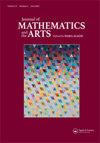Conversations in a foreign language
IF 0.2
Q4 MATHEMATICS, INTERDISCIPLINARY APPLICATIONS
引用次数: 0
Abstract
Topology and art were firmly connected as I was growing up. My artist uncle’s painting of an Alexander horn sphere hung on the dining room wall. My topologist father would delight in showing my siblings and me the strange qualities of the Mobius strip and of, what was to us, the very bizarre Klein bottle and, of course, the famous doughnut-coffee mug. His enthusiasm for these surfaces found room inmy imagination and they have been nestled in there, embedded, ever since. So too the tantalizing and challenging mystery of 4-space, the mathematician’s fourth dimension. If ever I had any doubt that topology and art were natural bedfellows, over here in London, Britain’s flagship modern art gallery, Tate Modern, held a symposium called simply; ‘Topology’. (November 2011 – June 2011). For themost part I work in 2-D and use traditional materials. I draw on fine papers with pencil, charcoal and pastel. I have several rules I impose on myself as I work. I set out a composition using the renaissance practice of rebatement. This is the geometric division of the canvas used to steer the viewer’s eye to all areas of the image and to direct the main focus on the critical parts of the narrative (Bouleu, 1963). I remain faithful to the topological rules of no tearing, cutting or intersecting of the surfaces and no puncturing either, however representing surfaces that intersect in 3-space but do not intersect in 4-space in a 2-dimensional image is a challenge to say the least. Some topological surfaces can engender so many ideas that I have to be firm and temper the wanderings of my imagination. The constraints of the topological surface in the question, the medium in use and staying true to my original inspiration present exactly the kind of challenges that I delight in. For many people even the mention of mathematics is off-putting and mathematical art can seem an oxymoron but there are ways to circumvent this reluctance. Beauty and grace are alluring and can be powerfully persuasive and with topologically derived art there is no need to apply these qualities superficially. They are built-in. As the coffee mug can morph into a doughnut, the Hopf link, two simple interlinked rings, can morph into multiple forms. In the drawing ‘Conversations in a Foreign Language; Three Solid Arguments’ (Figure 1) three solid forms bounded byHopf links are each presented from five different viewpoints. (The models for these forms are three small clay用外语对话
在我成长的过程中,拓扑学和艺术紧密相连。我的艺术家叔叔画的亚历山大角球挂在餐厅的墙上。我的拓拓学家父亲会很高兴地向我和我的兄弟姐妹们展示莫比乌斯带的奇怪特性,以及对我们来说非常奇怪的克莱因瓶,当然还有著名的甜甜圈咖啡杯。他对这些表面的热情在我的想象中找到了空间,从那时起,它们就一直依偎在那里,嵌入其中。四维空间,也就是数学家的四维空间,也是如此。如果说我曾经怀疑拓扑学和艺术是天生的伙伴,那么在伦敦这里,英国现代艺术的旗舰画廊泰特现代美术馆(Tate modern)举办了一场研讨会,名字很简单:“拓扑”。(2011年11月- 2011年6月)。大多数情况下,我都是在二维空间中工作,使用传统的材料。我用铅笔、木炭和粉彩在精美的纸上画画。我在工作时给自己定了几条规矩。我用文艺复兴时期的回帖手法写了一篇作文。这是画布的几何划分,用于引导观众的眼睛到图像的所有区域,并将主要焦点集中在叙事的关键部分(Bouleu, 1963)。我仍然忠实于拓扑规则,即不撕裂,切割或交叉表面,也不刺穿,然而,在二维图像中表示在三维空间中相交但不在四维空间中相交的表面,至少可以说是一个挑战。一些拓扑表面可以产生太多的想法,我必须坚定和调和我的想象力的漫游。问题中拓扑表面的限制,所使用的媒介,以及忠于我最初的灵感,这些都是我所喜欢的挑战。对许多人来说,甚至提到数学都是令人反感的,数学艺术似乎是一种矛盾修饰法,但有一些方法可以绕过这种不情愿。美丽和优雅是诱人的,可以具有强大的说服力,对于拓扑衍生的艺术,没有必要肤浅地应用这些品质。它们是内置的。就像咖啡杯可以变成甜甜圈一样,Hopf环,两个简单的相互连接的环,也可以变成多种形式。在绘画《外语对话》中;三个实论据(图1)三个由hopf链接限定的实论据分别从五个不同的观点提出。(这些形式的模型是三个小粘土
本文章由计算机程序翻译,如有差异,请以英文原文为准。
求助全文
约1分钟内获得全文
求助全文
来源期刊

Journal of Mathematics and the Arts
MATHEMATICS, INTERDISCIPLINARY APPLICATIONS-
CiteScore
0.50
自引率
0.00%
发文量
19
 求助内容:
求助内容: 应助结果提醒方式:
应助结果提醒方式:


